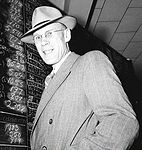| |||||||||||||||||||||||||||||||||||||||||||||||||||||||||||||||||||||||||||||
60 seats in the Legislative Assembly of Alberta 31 seats were needed for a majority | |||||||||||||||||||||||||||||||||||||||||||||||||||||||||||||||||||||||||||||
|---|---|---|---|---|---|---|---|---|---|---|---|---|---|---|---|---|---|---|---|---|---|---|---|---|---|---|---|---|---|---|---|---|---|---|---|---|---|---|---|---|---|---|---|---|---|---|---|---|---|---|---|---|---|---|---|---|---|---|---|---|---|---|---|---|---|---|---|---|---|---|---|---|---|---|---|---|---|
| |||||||||||||||||||||||||||||||||||||||||||||||||||||||||||||||||||||||||||||
| |||||||||||||||||||||||||||||||||||||||||||||||||||||||||||||||||||||||||||||
The 1944 Alberta general election was held on August 8, 1944 to elect members of the Legislative Assembly of Alberta.
In this election, Armed Forces voters voted for separate representation - by electing an Army, an Air Force and a Navy representative.[1]
The election was the first contested by leader Ernest C. Manning. Previously Provincial Secretary, he became leader of the Social Credit Party and premier after party founder, Premier William Aberhart, died in 1943. Manning steered the party down a more moderate path, largely dispensing with the party's social credit policies of monetary reform that it had been mostly unable to implement. The provinces's improved economic position meanwhile made such reforms less pressing.
Manning led Social Credit to a third term in government with a resounding victory in the 1944 election, winning over 50% of the popular vote on the first count of ballots.
The Conservative party and former United Farmers continued their strategy of running joint candidates as independents. Not supported by the Liberals, who left the coalition, the anti-SC joint effort lost much of its previous share of the popular vote.
The Co-operative Commonwealth Federation entered the election with only one seat in the legislature belonging to party leader Elmer Roper who had won a 1942 by-election. Despite winning almost a quarter of the popular vote the party won only two seats in the general election.
Albertan servicemen and veterans from World War II were able to vote in the first phase of the election on August 4, 1944. There was also a second vote held to elect three Canadian Armed Forces representatives from amongst the Albertans who were in active service overseas, or those who missed the first vote.
This provincial election, like the previous four, saw district-level proportional representation (Single transferable voting) used to elect the MLAs of Edmonton and Calgary. City-wide districts were used to elect multiple MLAs in the cities. All the other MLAs were elected in single-member districts through Instant-runoff voting. All voters in the province had the opportunity to cast ranked ballots.
- ^ A Century of Democracy (Centennial series)
© MMXXIII Rich X Search. We shall prevail. All rights reserved. Rich X Search


